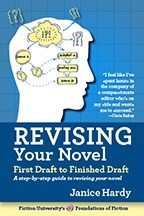How to Stay Organized During a Revision
Hi, everyone! Becca and I are back from our break and ready to rumble. We spent the week visiting with relatives, hosting dinner parties, catching up on the many projects that there’s never enough time for, and I managed to create a bunch of new nifty writing checklists.
(Watch for those in a coming post, or visit this insanely helpful Pinterest board if you just can’t wait!)
 Today however, we have author and writing coach Janice Hardy (@Janice_Hardy) here with some terrific revision advice, so please read on:
Today however, we have author and writing coach Janice Hardy (@Janice_Hardy) here with some terrific revision advice, so please read on:
Revising your novel can be a huge undertaking, and like any large project, going into it prepared can save you time and frustration. It can also help you complete that project in the most efficient and effective way.
How much feedback your manuscript gets before you start revising determines how much you have to keep track of. Detailed critiques from ten beta readers yields a lot more information than a first draft with no outside comments. Keeping track of it all can be challenging, but totally doable.
Step One: Gather Your Materials
Some writers like index cards and tape flags, others use three-ring binders and highlighters, and still others use software with electronic files instead of manila folders. Don’t forget about the non-writing essentials—your favorite drink or snack, reference guides, links to blog posts with great advice (such as Writers Helping Writers or my own site, Fiction University). If you think you’ll need it, put it within reach.
If you don’t have a preferred method yet, try these options:
Software: Collect all your notes and critiques in one file (or folder) in your favorite program. Microsoft Word’s Document Map feature is a handy way to create a table of contents to scan for what you want. Scrivener allows you to add extra text subfiles with everything you need right there per scene or chapter. Note-taking software keeps everything in one place, such as Microsoft’s OneNote or Evernote.
Three-ring binders and paper: For those who prefer a more hands-on approach, a binder can be the perfect fit. You can easily add and move pages as needed, and take notes anywhere. You might even have a separate binder for the manuscript itself, with notes and ideas written on the pages.
Tape flags and printed pages: Print out your manuscript and use different colored tape flags for different aspects of the revision. Tape additional sheets of paper to pages for extra notes, or write on the backs of the manuscript pages. Don’t forget scissors and tape if you go this route. Highlighters and colored pens are also useful.
Step Two: Gather Your Notes
Hunting through files for the feedback you want to address can be both time consuming and annoying. Collect everything in one place so you can easily access it when you reach that section of the revision. Create a story bible with important details to maintain consistency.
Put the notes into the manuscript file: Copy all the comments you want to address directly into the manuscript, so as you read through each scene, you’ll see what needs to be done. Add macro comments to the start of each chapter or scene, or in the beginning of the file. If you have multiple critiquers, you might use a different color per person or type of problem to address.
Create a master revision file: A master file with a summary and list of what you want to revise can provide a nice, step-by-step guide to follow—and a checklist to cross off when that aspect is done.
Print everything out: Hard copies could be a better option for those who prefer to edit from paper.
Use index cards: A popular organization method is to write out what needs to be done per scene on a index card, referencing page numbers or chapters. Put everything on one card, or use different color cards for different characters or options.
Step Three: Gather Your Thoughts
It’s not uncommon to try to tackle too much too fast, and end up frustrated and feeling like you’re not getting anywhere (or worse—that you’re just ruining the manuscript). Take the time you need to be in the right frame of mind to revise your novel and have fun with it.
There’s often a lot to keep track of during revisions, and a little planning before you dive in can make the entire process go more smoothly.
How do you prep for a revision? Do you prepare or dive in?
Win a 10-Page Critique From Janice Hardy
 To celebrate the release of my newest writing books, I’m going on a three-month blog tour–and each month, one lucky winner will receive a 10-page critique from me.
To celebrate the release of my newest writing books, I’m going on a three-month blog tour–and each month, one lucky winner will receive a 10-page critique from me.
It’s easy to enter. Simply visit leave a comment and enter the drawing via Rafflecopter. At the end of each month, I’ll randomly choose a winner.
a Rafflecopter giveaway
Looking for tips on revising your novel? Check out my new book Revising Your Novel: First Draft to Finished Draft , a series of self-guided workshops that help you revise your manuscript into a finished novel. Still working on your idea? Then try my just-released Planning Your Novel Workbook .
Janice Hardy is the award-winning author of The Healing Wars trilogy and the Foundations of Fiction series, including Planning Your Novel: Ideas and Structure, a self-guided workshop for planning or revising a novel, the companion Planning Your Novel Workbook, Revising Your Novel: First Draft to Finished Draft and the upcoming Understanding Show, Don’t Tell (And Really Getting It). She’s also the founder of the writing site, Fiction University.
Website | Facebook | Twitter | Goodreads | Amazon | Barnes & Noble | iTunes | Indie Bound
*Excerpted from Revising Your Novel: First Draft to Finished Draft
Save
Save
Save
Save
Save
The post How to Stay Organized During a Revision appeared first on WRITERS HELPING WRITERS®.
Writers Helping Writers
- Angela Ackerman's profile
- 1014 followers



